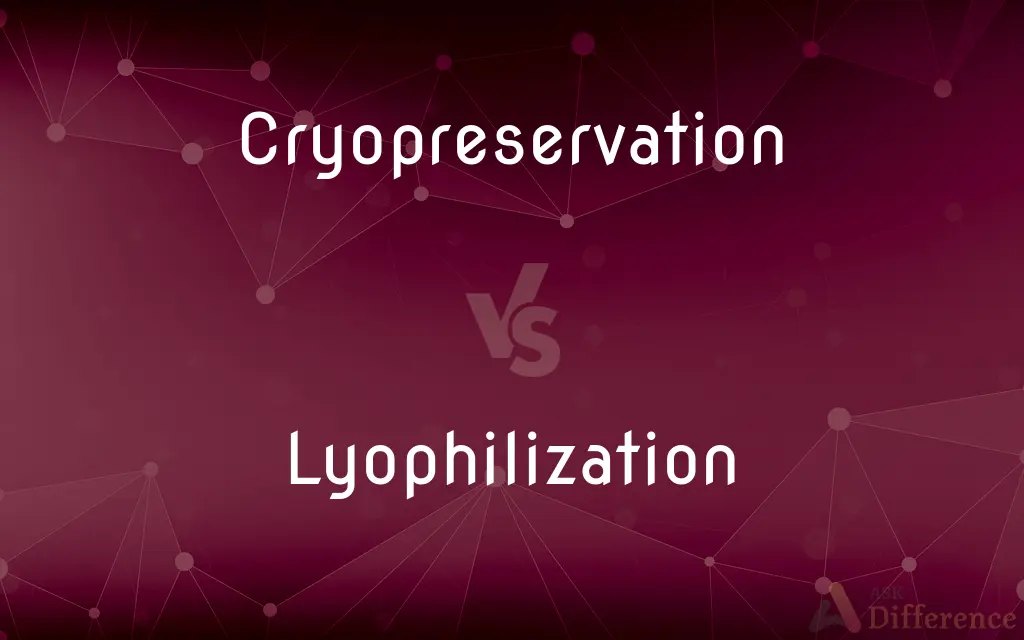Cryopreservation vs. Lyophilization — What's the Difference?
Edited by Tayyaba Rehman — By Fiza Rafique — Updated on April 26, 2024
Cryopreservation involves preserving biological materials at extremely low temperatures, typically using liquid nitrogen, while lyophilization (or freeze-drying) removes moisture under vacuum after freezing, maintaining stability.

Difference Between Cryopreservation and Lyophilization
Table of Contents
ADVERTISEMENT
Key Differences
Cryopreservation is primarily used to preserve whole cells, tissues, or other biological constructs by cooling them to sub-zero temperatures, thus halting all biological activity and metabolic processes. In contrast, lyophilization involves freezing the material and then reducing the surrounding pressure to allow the frozen water in the material to sublimate directly from ice to vapor.
Cryopreservation requires the use of cryoprotectants to protect the biological material from ice crystal formation, which can damage cell structures. Whereas lyophilization does not typically require protectants as the process itself minimizes damage by removing water at low temperatures and pressures, thereby preventing ice crystal formation.
The equipment used for cryopreservation includes freezers, liquid nitrogen storage tanks, and controlled-rate freezers, designed to cool samples at a controlled rate to optimize survival. On the other hand, lyophilization uses freeze-dryers or lyophilizers, which involve a vacuum system and a condenser to collect the sublimated water vapor.
Cryopreservation is crucial for long-term storage, as it keeps biological materials viable for extended periods by effectively "pausing" their current state. In contrast, lyophilization is favored for stability and distribution, as it significantly reduces weight and volume, facilitating easier transport and longer shelf life at ambient temperatures.
One common application of cryopreservation is in the storage of human reproductive cells, such as sperm and oocytes, and other valuable genetic materials. Lyophilization, meanwhile, is widely used in the pharmaceutical industry to extend the shelf life of drugs and vaccines by removing moisture, which is a key factor in chemical degradation.
ADVERTISEMENT
Comparison Chart
Definition
Preserving materials at very low temperatures using cryogens.
Drying materials by freezing and then vacuum drying.
Primary Use
Preserves biological integrity and function.
Preserves chemical stability and extends shelf life.
Equipment
Uses freezers, liquid nitrogen tanks.
Uses freeze-dryers, lyophilizers.
Requirement
Requires cryoprotectants to prevent ice damage.
Does not require protectants.
End Product Condition
Material remains frozen, requiring thawing before use.
Material is dry and can be used immediately.
Compare with Definitions
Cryopreservation
Preservation of cells, tissues, or any biological constructs by cooling to low temperatures.
Cryopreservation of embryos is vital for assisted reproductive technologies.
Lyophilization
A dehydration process that freezes the product, then reduces pressure to allow frozen water to vaporize.
Lyophilization is used to prepare stable pharmaceuticals.
Cryopreservation
Involves the use of liquid nitrogen or mechanical freezers.
Liquid nitrogen is essential for the cryopreservation of human oocytes.
Lyophilization
Enhances the shelf life and ease of transport of products.
Vaccines are often lyophilized for distribution in varied climates.
Cryopreservation
Requires careful control of cooling rates.
Controlled-rate freezers optimize cell survival during cryopreservation.
Lyophilization
Does not generally require cryoprotectants.
Lyophilization of food products helps in preserving flavor and nutrition without additives.
Cryopreservation
Typically involves storage at -196°C.
Stem cells are stored at cryogenic temperatures to maintain their viability.
Lyophilization
Common in the preparation of lab samples and drugs.
Lyophilization ensures the stability of enzyme samples for research.
Cryopreservation
Protects biological materials from degradation over time.
Cryopreservation is used for long-term conservation of rare plant seeds.
Lyophilization
Results in a dry powder form of the original material.
Instant coffee benefits from the quick solubility provided by lyophilization.
Cryopreservation
Cryo-preservation or cryo-conservation is a process where organelles, cells, tissues, extracellular matrix, organs, or any other biological constructs susceptible to damage caused by unregulated chemical kinetics are preserved by cooling to very low temperatures (typically −80 °C using solid carbon dioxide or −196 °C using liquid nitrogen). At low enough temperatures, any enzymatic or chemical activity which might cause damage to the biological material in question is effectively stopped.
Lyophilization
To freeze-dry (blood plasma or other biological substances).
Cryopreservation
To preserve (cells or tissue, for example) by freezing at very low temperatures.
Lyophilization
Freeze-drying; the removal of moisture from a frozen material using vacuum
Cryopreservation
The preservation of biological tissue at cryogenic temperatures, typically at -80°C (dry ice temperature) or -196°C (the boiling point of liquid nitrogen).
Lyophilization
A method of drying food or blood plasma or pharmaceuticals or tissue without destroying their physical structure; material is frozen and then warmed in a vacuum so that the ice sublimes
Common Curiosities
What is lyophilization commonly used for?
Mainly for increasing the stability and shelf life of pharmaceuticals and food products by removing moisture.
Can cryopreservation reverse biological activity?
Yes, once thawed, the biological activity in cryopreserved materials can often be restored.
What is the primary purpose of cryopreservation?
To maintain the viability of biological materials by halting all biological and chemical processes at extremely low temperatures.
What materials are commonly cryopreserved?
Cells, tissues, organs, and any biological constructs that require preservation in their functional state.
How does lyophilization affect the weight of the product?
It significantly reduces the weight by removing water content, making the product lighter and easier to transport.
What are the key differences in the equipment used in cryopreservation and lyophilization?
Cryopreservation uses equipment designed to reach and maintain extremely low temperatures, while lyophilization uses equipment that combines cold and vacuum to remove moisture.
How does cryopreservation affect cell viability?
If done correctly, it preserves cell viability by preventing ice crystal formation and other damaging effects of freezing.
What is sublimation in the context of lyophilization?
It's the process where ice changes directly to vapor without becoming liquid, a key mechanism in lyophilization.
Is it possible to cryopreserve any type of biological material?
Most biological materials can be cryopreserved, but the success rate can vary depending on the type of material and the freezing protocol used.
How long can materials be stored via lyophilization?
Depending on the material, lyophilized products can be stored for several years without significant degradation.
How does the storage temperature differ between cryopreservation and lyophilization?
Cryopreservation requires storage at temperatures as low as -196°C, while lyophilized products can be stored at room temperature.
Are cryoprotectants needed in lyophilization?
No, because lyophilization removes water by sublimation, which minimizes the risk of ice crystal formation and thus does not typically require protectants.
Can lyophilization be used for all types of drugs?
While it's highly beneficial for many types, some drugs may lose efficacy or require special formulations to be suitable for lyophilization.
What are the limitations of cryopreservation?
Requires specific equipment and materials like cryoprotectants, and there's always a risk of damage due to ice crystal formation if not handled correctly.
What are the benefits of using lyophilization in the pharmaceutical industry?
It helps in preserving the chemical and physical stability of drugs, allowing for easier storage and transportation.
Share Your Discovery

Previous Comparison
Cursive vs. Coercive
Next Comparison
Harvard vs. CambridgeAuthor Spotlight
Written by
Fiza RafiqueFiza Rafique is a skilled content writer at AskDifference.com, where she meticulously refines and enhances written pieces. Drawing from her vast editorial expertise, Fiza ensures clarity, accuracy, and precision in every article. Passionate about language, she continually seeks to elevate the quality of content for readers worldwide.
Edited by
Tayyaba RehmanTayyaba Rehman is a distinguished writer, currently serving as a primary contributor to askdifference.com. As a researcher in semantics and etymology, Tayyaba's passion for the complexity of languages and their distinctions has found a perfect home on the platform. Tayyaba delves into the intricacies of language, distinguishing between commonly confused words and phrases, thereby providing clarity for readers worldwide.














































